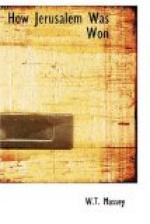General Chetwode’s Corps relieved General Bulfin’s Corps during the day of November 28, and viewed in the most favourable light it appeared that there must be at least one week’s work on the roads before it would be possible for heavy and field batteries, in sufficient strength to support an attack, to be got into the mountains. A new road was begun between Latron and Beit Likia, and another from Enab to Kubeibeh, and these, even in a rough state of completion, eased the situation very considerably. An enormous amount of labour was devoted to the main road. The surface was in bad order and was getting worse every hour with the passage of lorry traffic. It became full of holes, and the available metal in the neighbourhood was a friable limestone which, under heavy pressure during rains, was ground into the consistency of a thick cream. Pioneer battalions were reinforced by large parties of Egyptian labour corps, and these worked ceaselessly, clearing off top layers of mud, carrying stones down from the hills and breaking them, putting on a new surface and repairing the decayed walls which held up the road in many places. The roadmakers proved splendid fellows. They put a vast amount of energy into their work, but when the roads were improved rain gravely interfered with traffic, and camels were found to be most unsatisfactory. They slipped and fell and no reliance could be placed on a camel convoy getting to its destination in the hills. Two thousand donkeys were pressed into service, and with them the troops in the distant positions were kept supplied. It would not be possible to exaggerate the value of this donkey transport. In anticipation of the advance the Quartermaster-General’s department, with the foresight which characterised that department and all its branches throughout the campaign, searched Egypt for the proper stamp of asses for pack transport in the hills. The Egyptian donkey is a big fellow with a light-grey coat, capable of carrying a substantial load, hardy, generally docile, and less stubborn than most of the species. He is much taller and heavier than the Palestine donkey, and our Army never submitted him to the atrociously heavy loads which crush and break the spirit of the local Arabs’ animals. It is, perhaps, too much to hope that the natives will learn something from the British soldier’s treatment of animals. It was one of the sights of the campaign to see the donkey trains at work. They carried supplies which,




